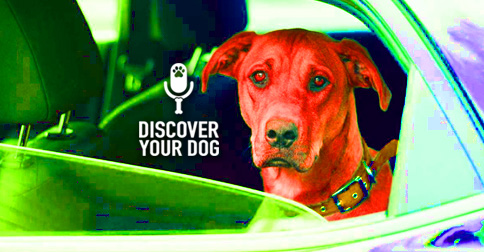 A car sick dog may have a behavioral issue completely unrelated to actually being sick.
A car sick dog may have a behavioral issue completely unrelated to actually being sick.
Discover useful ways to help your dog deal with the anxiety of car rides.

Show Highlights
- Dogs are becoming a bigger part of the family nowadays, and with that comes travel for your family and your pooch.
- Generally the reason why your dog gets sick in the car it is a behavioral issue, and NOT a motion sickness issues (the kind that can be fixed with Dramamine).
- Look at a dog’s car sickness as a reactive behavior, and how you as the owner are responding to this behavior.
- You may be reinforcing the issue that your dog is expected to be sick while in the car.
- Bennie went to ISA Experience (Institute of Self Actualization) this weekend, which is where Bennie met Devin and from this beautiful relationship came Discover Your Dog!
- One thing that was revealed to Bennie was “Why is it that we all think in this negative way—that I need to get my dog to stop doing this one thing.”
- We look at things as opposites, such as up and down, men and women.
- However, these things are complimentary as you cannot have one without the other. We look at them in an opposing view; one is bad and one is good when they are both just there.
- Thinking in the affirmative is the daily challenge.
- There are a few things that can create issues in the vehicle, such as while they are a puppy they had bad experiences in the car.
- If your vet recommends medication, Bennie believes you should still work on the behavioral issues with anxiety.
- Your dog can get so stressed out that as adult dogs they can cause themselves to get sick.
- Always remember how you react when your dog gets in the car, gets sick in the car, etc., because if you have a big reaction, it teaches them that they are supposed to act that way and this is the way you want them to act.
- In this moment a negative response would not be appropriate as it will carry on because you can create stress for the entire ride.
- Ignoring a behavior is the best way to correct a behavior.
- Be sure to clean up the issue, and never in front of your dog. There are so many reactions and interactions while you are doing it that you do not want your dog to be a part of.
- If your dog has lots of anxiety for getting into the car, Bennie will discuss some baby steps (without medication) that can be used to help them feel more comfortable with entering the car.
- You want your dog to associate car rides with good things.
- You always want to make getting in the car a big, happy and exciting deal such as you do when you crate train (Ep 073).
- Most people who do not take their dogs anywhere besides the vet need to be pay attention, because that is what your dog associates with getting into the car: a negative-ending experience.
- You need to start practicing with them so that, for every one trip to the vet (negative experience after a car ride), you create 10 positive car-riding experiences.
- Some of the ways you can end a drive in a positive way:
- Take your dog to a friend’s home that has another dog, or loves dog
- Take them to the dog park (to Bennie this is more for a social exercise for your dog)
- You can go for a walk on the greenway
- You can just go somewhere to play that is big and fenced in and they can be off the leash
- Something inherently fun
Homework
Puppy Steps to get your dog to enjoy car rides.
- You should do this even if you don’t take your dog in the car.
- Walk your dog around the car on the leash with the doors closed for about a week.
- Give it a week with no exposure to the car with the intent of the car being the item of emphasis.
- With a treat, you are going to start coaxing your dog into the car. If the car is tall, put a treat on the floor board. If the car is really low, then open both back doors and holding onto the leash to give just a little resistance to help them jump into the car and get the treat and get right back out of the car for about a week.
- If you have to pick your dog up to get into the car—you want to avoid touch as much as possible—but you have to always have the leash on and assist your dog.
- You don’t want to encourage the resistance, so do your best to get them in the car and right back out. Do this for about a week and then take a few days off.
- Then, you sit in the car with them for about 30 seconds, building up to a minute without turning the car on.
- After about a week of that and your dog is relaxed, keep them in the backseat and you stay in the front.
- Every time you get out of the car with them you make it a big deal with lots of love and excitement.
- After they are comfortable with staying in the back seat and you in the front, turn the car on for about a minute to 5 minutes until they are comfortable.
- Take a few days off and then pull out of the driveway and back into the driveway. You want your dog to stay calm and once they are acclimated, drive up and down the block.
- If you have a park or something close by (within a mile), drive them there and do something fun afterwards at your stop. Example: going for a walk or playing with you at a separate location.
- Remember to do the exercise for about a week at a time then take a few days off.
- These baby steps are meant for dogs that are having motion sickness or very hesitant to get into the car or if your dog has had a past history of getting sick, these baby steps will be helpful.
- If your dog has a recent negative connotation with the car give it a few weeks to a month before you start this new training as you do not want to create anxiety for your dog while starting this process.
- These are all behavioral issues—if your dog is still getting sick, then you need to take your dog to the vet and make sure there is nothing physically wrong with her.
Call to Action
Go to FamilyDogFusion.com/insurance to check out Healthy Paws Pet Insurance
Get In Touch
Check out our show page in iTunes to leave comments and subscribe or send us a message.
Leave a Reply